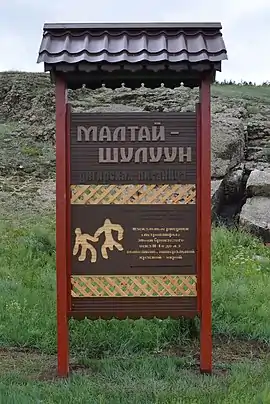Ulan-Burgas
Ulan-Burgas (Russian: Улан-Бургасы; Buryat: Улаан бургааhан, from улаан - "red", and бургааһан, "small birch" or "shrub"),[1] is a mountain range in Buryatia, Russia.
| Ulan-Burgas | |
|---|---|
| Russian: Улан-Бургасы Buryat: Улаан бургааhан | |
 Landscape of the Ulan-Burgas range from Mount Lysoy, Ulan-Ude | |
| Highest point | |
| Peak | Khurkhag |
| Elevation | 2,033 m (6,670 ft) |
| Dimensions | |
| Length | 200 km (120 mi) NE/SW |
| Width | 50 km (31 mi) NW/SE |
| Geography | |
 Location in Buryatia, Russia | |
| Country | Russia |
| Federal subject | Buryatia |
| Range coordinates | 52°50′N 109°3′E |
| Parent range | South Siberian System |
| Borders on | Selenga Highlands |
| Geology | |
| Type of rock | Metamorphic rock with granite intrusions |
| Climbing | |
| Easiest route | From Ulan-Ude |
The range is located close to Ulan-Ude, the capital of Buryatia.[2]
Geography
The Ulan-Burgas range is located in Central Buryatia. It rises east of the Baikal Lake, stretching for 200 kilometres (120 mi) from southwest to northeast between the valley of the Selenga River to the Vitim Plateau. The width of the range is from 30 kilometres (19 mi) and 50 kilometres (31 mi) and its average elevation between 1,400 m (4,600 ft) and 1,800 m (5,900 ft). The highest peak is Khurkhag at 2,033 m (6,670 ft) located in the central part.[3]
The northeastern end of the Ulan-Burgas connects with the Ikat Range and the eastern and southern ends are part of the Selenga Highlands.[4] At one end of the range is the valley of the Turka River that flows into Lake Baikal and at the other end the Kurba, a right tributary of the Uda from the Selenga River basin.[5]
 Maltai-Shulun Bronze Age petroglyphs, an archaeological site located at the feet of the Ulan-Burgas Range. |
Flora
The slopes of the range are mainly covered with Alpine-steppe vegetation from the foot of the mountains to an elevation between 700 m (2,300 ft) and 800 m (2,600 ft), above which in most of the parts of the range there is a larch taiga forest belt up to about 1,600 m (5,200 ft). The higher elevations are topped by "golets" type bare summits.[3]
See also
References
- Мельхеев М. Н. Географические названия Восточной Сибири (Melkheev M.N. Geographical names of Eastern Siberia) (in Russian)
- Google Earth
- , Great Soviet Encyclopedia in 30 vols. / Ch. ed. A.M. Prokhorov - 3rd ed. - M, 1969-1978.
- Natalʹi︠a︡ Vasilʹevna Fadeeva, Селенгинское среднегорье: природные условия и районирование (Selenga Highlands: Natural Conditions and Zoning) Buryat Book Publishing House, 1963 - Physical geography - 169 pages, (in Russian)
- Topographic map sheets N-49-XXV, N-49-XXVI, N-49-XXXI and N-48-XXXV. Scale: 1: 200 000. (in Russian)
External links
 Media related to Ulan-Burgas at Wikimedia Commons
Media related to Ulan-Burgas at Wikimedia Commons